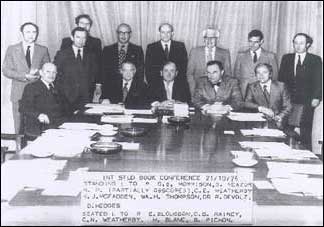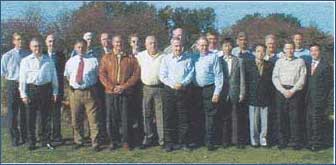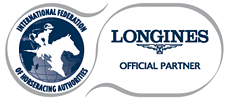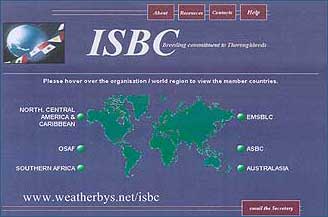|
Presentation made at the 2002 Paris Conference by
PAUL GREEVES,
Operations Director of Weatherbys on behalf of Johnny Weatherby,
Chairman of the International Stud Book Committee
|
|

HISTORY
The International Stud Book Committee (ISBC) first
met in October 1976 and
did so as a Conference not the Committee which it later became.
 Photograph of the attendees at that very first gathering.
Photograph of the attendees at that very first gathering.
|
|
What could have brought about this momentous gathering?
An examination of the records of the Tenth International Conference of
Racing Authorities (Paris Conference) and the notes of the ISBC proceedings
indicates that procedural and policy differences and unresolved issues
between Stud Book Authorities around the world were becoming a barrier
to free and effective movement of horses.
These differences involved subjects which required special
expertise and the Paris Conference, whilst not the appropriate forum for
their discussion, was becoming embroiled in trying to resolve them. Thus
the Paris Conference suggested to the major Stud Book Authorities that
they should meet to find a better way to tackle and resolve these problems.
An effective means of communication and decision making amongst Stud Book
Authorities was urgently needed.
Stud Book Authorities had spent decades if not centuries
in relatively insular pursuit of their task of accurately recording and
publishing details of all thoroughbreds. The growing movement of racehorses
and the breeding stock required a new consistent and modern approach and
it was in 1976 and specifically, the formation of ISBC, which saw positive
steps taken to tackle this requirement.
|
|
|
EVOLUTION OF POLICY
Weatherbys and their then Chairman, Christopher Weatherby,
were asked by the 1976 Paris Conference to organise the first gathering
took place on October 21st 1976. Immediate progress was made. The minutes
of this gathering record that it was decided to:
- set up an International forum for standardisation of Conditions of
Entry for Stud Books;
- finalise criteria for promotion to thoroughbred status;
- establish effective communication of proposals and decisions to all
Stud Book Authorities;
- create the ISBC as a separate but complementary organisation to the
Paris Conference, serviced by Weatherbys, but with minutes circulated
with those of the Paris Conference - (later this was replaced by delivery
of a report by the Chairman of the ISBC annually to the Paris Conference).
|
|
The early years of operation were not without difficulty,
even some tension, as the different approaches and practices of the major
Stud Book Authorities, which had built up over centuries, were tackled
and reconciled.
When studying the minutes of those first years, one can
record that these early challenging times taught the ISBC some lessons
which still guide the conduct today. Records indicate that the members
accepted, over time, that:
- members should recognise that each is responsible for Stud Books in
their own Areas and cannot be forced into decisions which national considerations
would not allow.
- But, that members should strive to reach unanimous decisions wherever
possible.
- Expertise and continuity in the Committee's membership is essential.
Some subjects need two or three years of informed debate.
- The ISBC needs members who really know their subject in detail and
can ensure full promulgation of decisions.
- The ISBC should look for and expect members to be independent from
breeders but that a practical degree of independence should be shown.
|
|
Importantly in 1995 the maturity of the ISBC was further
demonstrated when it agreed a Mission Statement which was and is as follows:
The mission of the International Stud Book Committee
is to establish standards of Stud Book operation that will ensure
the integrity and future development of the Thoroughbred breed and
provide the foundation necessary for a healthy international Thoroughbred
industry. To accomplish this mission, the Committee will:
- operating and maintaining a Thoroughbred Stud Book,
- breeding and identification of Thoroughbred horses,
- the movement of Thoroughbreds between Stud Book Authorities.
- Review the procedures used by emerging Stud Book Authorities in the
registration of Thoroughbreds; to ensure that those procedures meet
the established standards.
- Establish standards for reporting of information on Thoroughbred breeding,
including:
- Publication of foal crop information
- Sharing of pedigree information
- Make recommendations to Stud Book Authorities on how technology can
be applied to benefit the breed and its management.
|
|
|
MEMBERSHIP AND COMMUNICATION
The ISBC started its life as a Conference but by 1979
it had moved on to operate as a Committee. Interest in the forum in those
early years grew rapidly and it was clear to the original membership that
they needed to find an effective means of communicating with the many
and varied Stud Book Authorities around the world.
But, the nature and complexities of the subjects on the
agenda meant that convening a meeting attended by all the Stud Book Authorities
of the world was an impractical proposition and would make decision making
most difficult.
It was decided that a better approach would be to operate
via an annual meeting of a limited membership of principal Authorities
timed to convene prior to the Paris Conference and tasked with communicating
to all other Stud Book Authorities through Area conferences.
This arrangement prevails today. The membership of the
International Stud book Committee is therefore restricted and each member
is charged with representing its Area of the globe and with liaising with
all Stud Book Authorities in their Area. The members and the Areas they
represent are as follows:
|
|
|
Member
|
Area
|
|
|
|
Argentina
|
South America
|
|
|
|
Australia
|
Australia
|
|
|
|
France
Great Britain & Ireland
|
European & Mediterranean
|
|
|
|
South Africa
|
Southern & Central Africa
|
|
|
|
USA
|
North America, Central America & Caribbean
|
|
|
Johnny Weatherby is the latest member of the Weatherby
family to hold the Chair and Weatherbys also provide the Secretariat.
Members contribute to the costs of operation on a per country basis, and
meetings are held annually. In the past the meetings have all been in
Britain but it is now planned that they should take place every other
year in Britain and by rotation in other member countries in intervening
years.
The area conference and communication channels bring
70 Stud Book Authorities together. These are interesting given their diversity.
The great majority are now Approved Stud Books but a number have yet to
achieve this status so remain in the emerging Stud Book category. These
are shown with an asterix in the following list of countries under their
Areas:
|
|
The North American, Central America & Caribbean
Area comprises 10 countries:
|
|
|
Barbados
|
Mexico
|
|
|
|
Costa Rica
|
Panama
|
|
|
|
Dominican Republic
|
Trinidad & Tobago
|
|
|
|
Guatemala
|
USA
|
|
|
|
Jamaica*
|
|
|
|
The Australasian Area comprises just:
|
|
|
Australia
New Zealand
|
|
|
|
Southern and Central Africa similarly consists of just
2 countries:
|
|
|
Kenya
South Africa
|
|
|
|
South America (O.S.A.F.) comprises 10:
|
|
|
Argentina
|
Ecuador
|
|
|
|
Bolivia*
|
Paraguay
|
|
|
|
Brazil
|
Peru
|
|
|
|
Chile
|
Uruguay
|
|
|
|
Columbia
|
Venezuela
|
|
|
The Asian Stud Book Conference has 16 member countries
|
|
|
Bahrain
|
Oman*
|
|
|
|
China
|
Pakistan*
|
|
|
|
India
|
Qatar
|
|
|
|
Iran*
|
Philippines
|
|
|
|
Japan
|
Saudi Arabia
|
|
|
|
Korea
|
Thailand
|
|
|
|
Kuwait*
|
Turkey
|
|
|
|
Malaysia
|
UAE
|
|
|
and the European and Mediterranean Stud Book Liaison
Committee has the greatest membership at 31 countries:
|
|
|
Algeria*
|
Italy
|
|
|
|
Austria
|
Morocco
|
|
|
|
Belgium
|
Netherlands
|
|
|
|
Bulgaria*
|
Norway
|
|
|
|
Croatia*
|
Poland
|
|
|
|
Cyprus
|
Portugal
|
|
|
|
Czech Republic
|
Rumania*
|
|
|
|
Denmark
|
Russia
|
|
|
|
Finland*
|
Serbia & Montenegro*
|
|
|
|
France
|
Slovak Republic
|
|
|
|
Germany
|
Slovenia
|
|
|
|
Great Britain
|
Spain
|
|
|
|
Greece
|
Sweden
|
|
|
|
Hungary
|
Switzerland
|
|
|
|
Ireland
|
Tunisia
|
|
|
|
Israel
|
|
|
|
Effective communication has been greatly enhanced by
a comprehensive Internet web site which allows members to place papers,
proposals and reports on the site for others to consider and view. Meeting
agendas appear in full as of course do minutes. The site also provides
an interactive 'chat room' for members to discuss issues and develop discussion
between meetings.
|
|
|
|
SUBJECTS AND ISSUES ADDRESSED
The breadth of the subjects which the ISBC has tackled
and the depth of discussion and analysis of them is impressive. In fact
it now seems inconceivable that the Stud Book Authorities of the world
did not meet annually prior to 1976. Any examination of the history of
the ISBC would be woefully incomplete without showing a selection of the
subjects which the ISBC has addressed. Some are constant entries on the
annual agenda.
- Definition of The Thoroughbred - was the first major subject
addressed in detail and required very careful consideration. Every member
had a slightly different definition. This meant that certain horses,
although accepted in their own domestic Stud Books, were not accepted
in the Stud Books of other countries because of perceived pedigree flaws,
often dating back well over a century. For an industry looking to international
expansion this was an unacceptable barrier.
After a great deal of discussion, the Committee decided mutually to
accept, without question, the pedigrees of every horse in each of its
member's Stud Books up to the beginning of 1980.
This pragmatic approach produced the very clear digestible practice
now embodied in Article 12 of the International Agreement on Breeding
and Racing - with the requirement that entry in a Thoroughbred Stud
Book is now only dependant upon registration of antecedents of a produce
in a Stud Book approved by the International Stud Book Committee. This
important achievement has eradicated the old problem of one Stud Book
Authority accepting a bloodline but another refusing to do so. It was
a momentous decision in the history of the recording of thoroughbreds
and removed considerable barriers to the movement and exchange of breeding
stock.
- Approved Stud Books - one of the main tasks which emerged from
early discussions was the need to establish minimum standards of operation
for Stud Book Authorities in order that Racing Authorities and the industry
in general could be confident of the origins and identity of horses.
Not unlike the first subject mentioned this led to debate over many
years and to an evolutionary approach resulting in present policy. Originally
a two tier system was devised with 'recognised' Stud Books and 'approved'.
Eventually this was simplified and the single status of 'approved' was
adopted. The ISBC therefore now maintains a list of Approved Stud Books
on which the industry can rely.
The list of Approved Stud Books appears in Appendix
10 of the International Agreement. The number has grown to 55.
ISBC bases approval on a set of requirements which it uses both to monitor
the performance of Stud book Authorities already on the Approved List
and to test the efficacy of emerging Stud Books seeking Approval.
This set of requirements covers procedures for registration of breeding
stock, recording of breeding results, export and import movements, publication
of relevant data and issue of documentation.
Some recent additions to the Approved List have been Bahrain, Qatar,
Tunisia and China. Others will follow.
- Artificial Insemination / Embryo Transfer - were amongst the
first issues discussed and continue to find a prominent place on the
current agenda. Support for maintenance of a ban has generally been
resolute but, debate has always been healthy including liaison with
Breeders' Associations.
The ISBC has always recognised that a challenge to the ban on AI may
come but in common with Racing Authorities, has maintained that it would
not be in the interest of the industry to change.
Members of the IFHA will indeed be aware that the Australian Stud Book
Authority has been challenged to accept a foal resulting from embryo
transfer and it may yet face legal action over its refusal to record
the resulting produce.
- Blood Typing / DNA - these tools are now indispensable to the
accurate recording of thoroughbreds worldwide. The ISBC has addressed
and agreed all protocols and standards whilst overseeing both the introduction
of blood typing and more recently, highly effective DNA testing. These
advances have revolutionised the process of recording the birth of foals
bringing with DNA certainty over the accuracy of published pedigrees.
The ISBC has agreed that from 2002 onwards all foals recorded in an
Approved Stud Book must be parentage tested.
ISBC also oversees the maintenance of common and effective standards
of testing through the International Society of Animal Geneticists.
- Promotion of Mares and Stallions to Vehicle Status - it is
important for good order that all Stud Books should have a common approach
to the eligibility of evolving bloodlines. Thoroughbred status is achieved
after 8 successive crosses of thoroughbred blood and the produce of
the seventh cross, if accepted by ISBC, is designated a "vehicle" mare/stallion.
The ISBC is the acknowledged authority which can grant this status which
is then recognised worldwide.
- Minimum Content of a Thoroughbred Stud Book - is perhaps a
subject of less obvious impact but is nonetheless important. The ISBC
has set standards for all Stud Book Authorities to follow, such that
all published Stud Books not only contain foaling records but also lists
of imports and exports, updates on name registrations and a statistical
summary.
- Similarly ISBC has agreed a Minimum Content for Stud Books Published
on the Internet - this is of course a topical issue and may well
be the preferred means of publication in the future. Stud Books are
very costly to print and publish and have very limited sales potential.
The ISBC has provided the forum whereby those who most rely on the data
determine just how much information must be included in an electronic
publication.
- Electronic Transfer of Export Documentation - the ISBC utilising
the technology of the American Jockey Club and Weatherbys has been active
in developing systems which provide speedier transfer of vital horse
details securely between Authorities when horses are permanently exported.
It is possible that the major Authorities will move to electronic exchange
rather than paper documentation with all the benefits of speed and ease
of access which accompany it.
- Horse Identification - this is a topic of vital importance
to both Stud Book and Racing Authorities. The ISBC has assisted progress
via a number of initiatives including introduction of unique life numbers,
moves to improve the standard of written and graphic descriptions and
the setting of standards and procedures for the use of microchips as
a complementary process supporting universally established identification
techniques.
This is far from an exhaustive list of subjects tackled by ISBC merely
an illustration. Other subjects addressed have been many and diverse of
which the following is merely an illustration.
- Intersexed horses.
- Official birthdates, and covering seasons.
Naming issues including international protection of exceptional stallions
and mares.
The ISBC members also provide other Stud Book authorities
technical and practical Support whenever required. A good example concerns
the diligent, patient and dedicated work carried out on behalf of the
Russian Stud Book to deal with the major problem of the thousands of horses
displaced during the Second World War whose documentation was lost. The
ISBC Secretariat spent three years sifting through records and visiting
relevant studs to take statements before resolving all the issues.
THE FUTURE
The emergence of racing and breeding as a truly international
industry and sport has brought with it the need for its leaders and executives
to maintain effective communication and a harmonised approach to administration.
Only then can horses move freely without the risk of encountering frustrating
bureaucratic barriers. The International Stud Book Committee came into
existence to meet this challenge and is now firmly established as the
body which oversees and co-ordinate the policies and practices of all
Stud Book Authorities around the world.
It does of course work firmly alongside this organisation,
the International Federation of Horseracing Authorities, working to ensure
maximum commonality of approach amongst both Racing and Stud Book Authorities
and will continue to do so. Its meetings will no doubt continue to take
place before the IFHA meets in order that its proceedings and decisions
can be recorded at the Paris Conference each year.
The ISBC will deal with all subjects which emerge to
pose questions for Stud Book Authorities and it is already evident that
scientific advances will bring new challenges. It is not too difficult
to envisage that future ISBC agendas might include subjects such as :
Cloning
Genomes
Satellite tracking
Emerging Stud Book Authorities will be assisted and approved
if they can meet the ISBC's exacting standards and there will be still
greater use of the Internet for documentation transfer. Electronic publication
of Stud Book records will be pursued if it continues to ease the path
of the ever increasing number of thoroughbreds travelling the world.
|
|
Above all else the ISBC will continue to:
- Facilitate the movement of thoroughbreds around the world
- act in unison · liaise closely with Breeders representatives
- work with and complement the role of the International Federation
of Horseracing Authorities
- act in the interest of the breeding industry as a whole
All the members of the ISBC have to be thanked for the tremendous contribution
they have made over the years. Here we have the Members at Newmarket last
week who worked extremely hard in the interest of the subject of all our
efforts, the magnificent thoroughbred.
|
|

2002 ISBC meeting held at Newmarket
|







